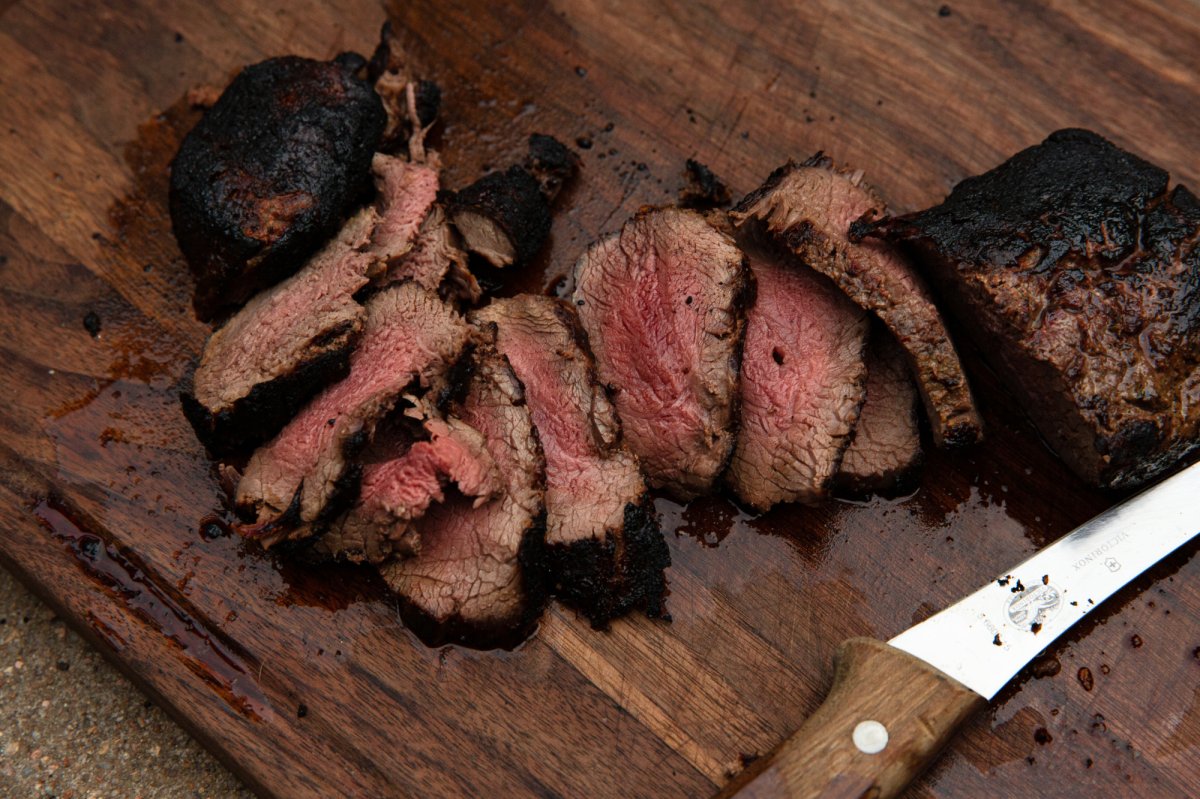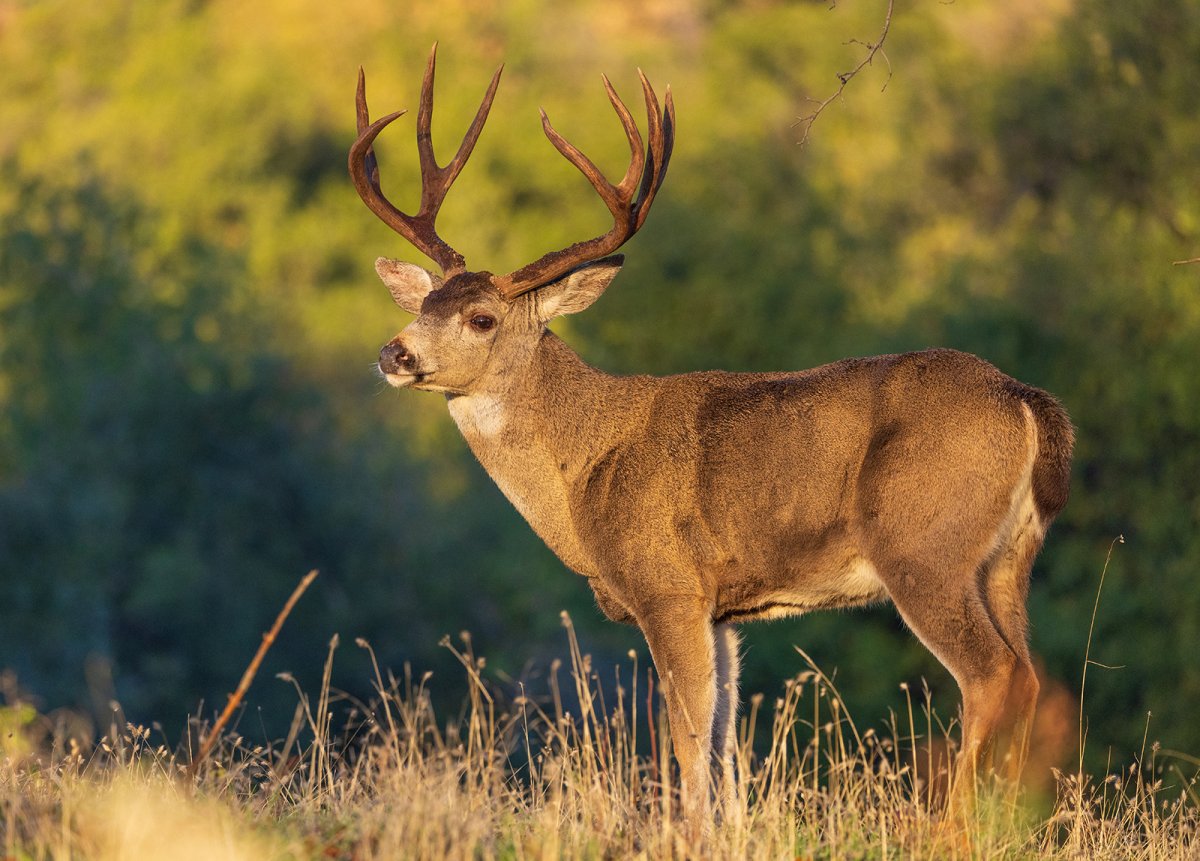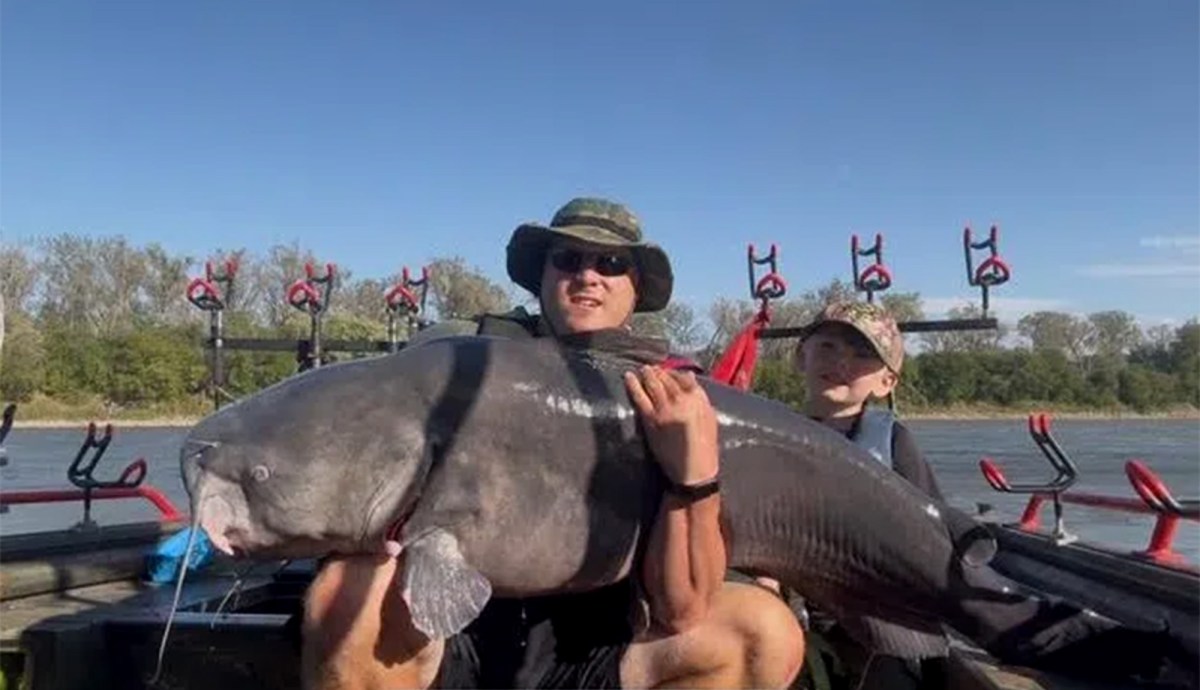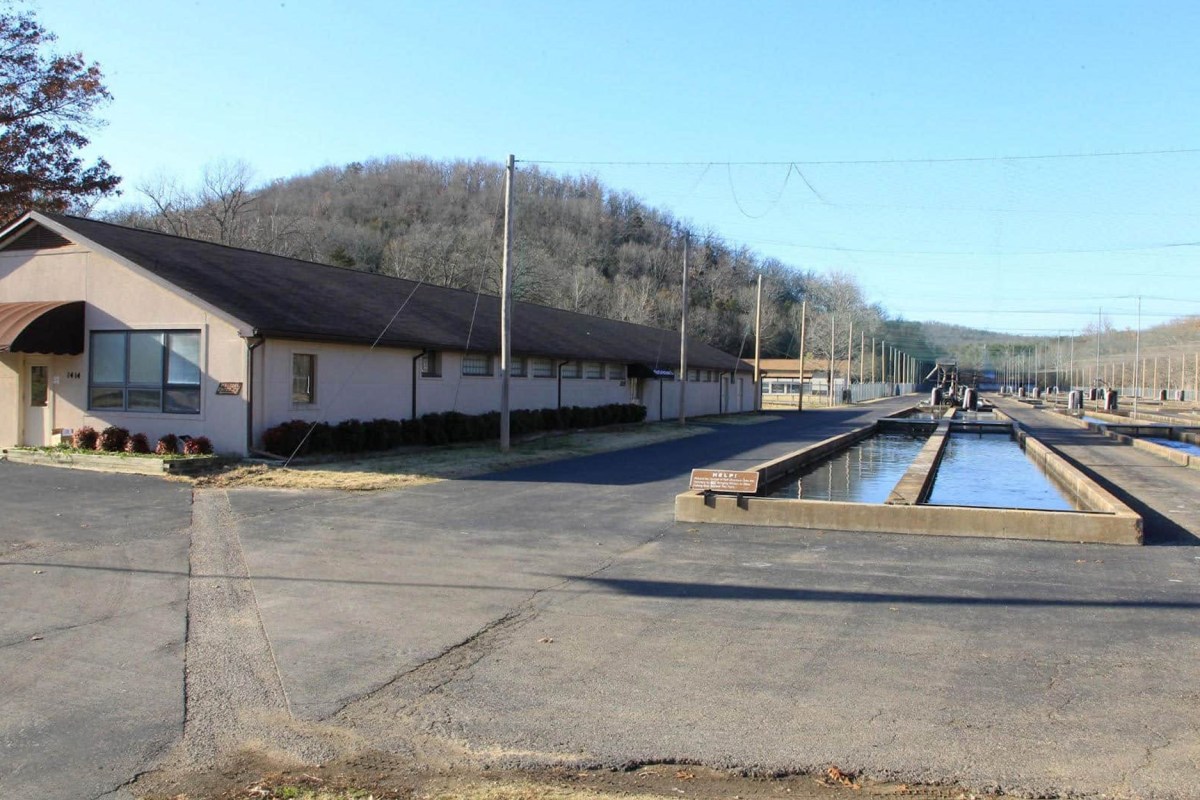My .30-30 Winchester Is Better Than Your Fancy Rifle
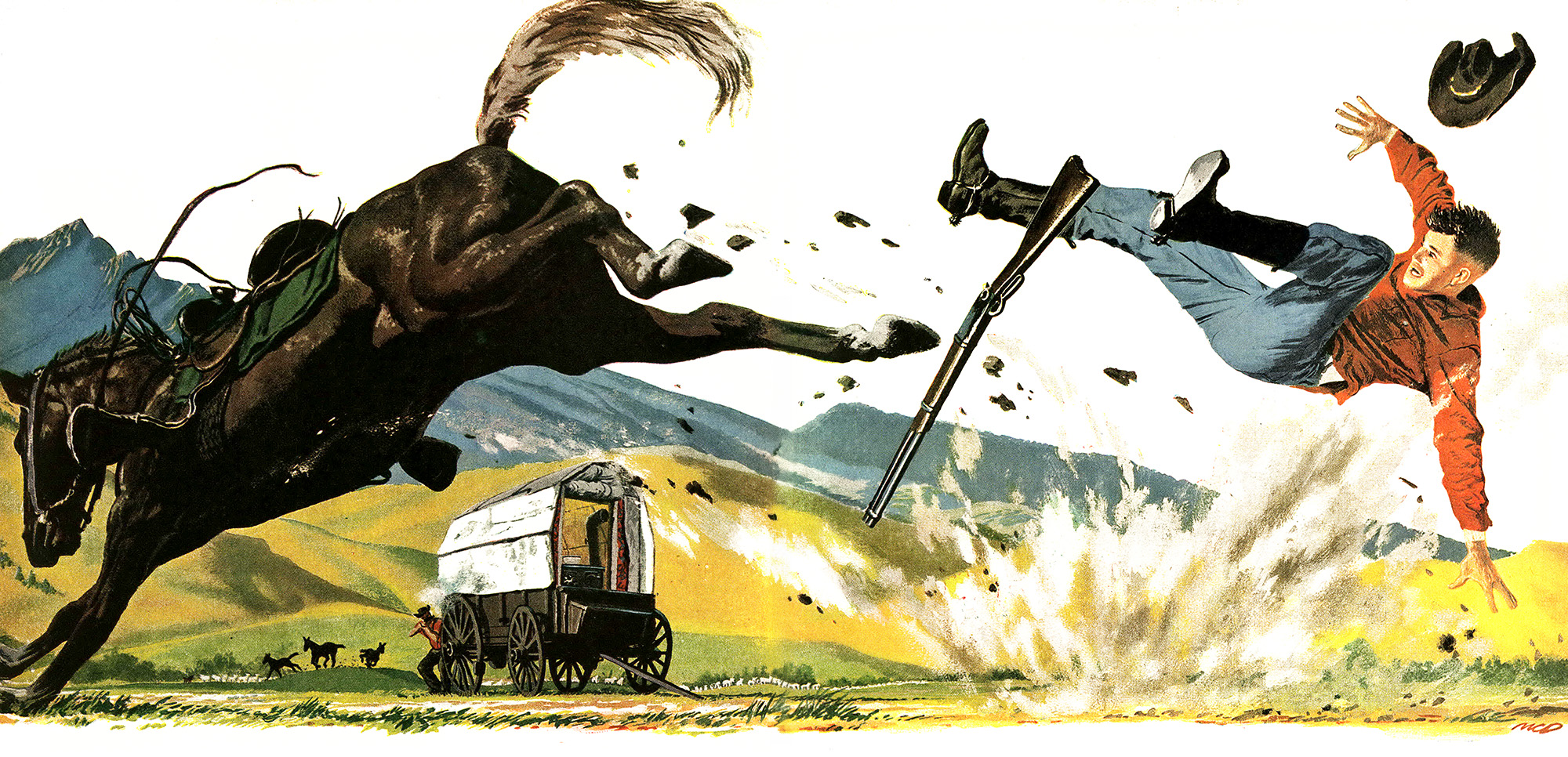
This story, “The Old Saddle Carbine,” appeared in the December 1952 issue of Outdoor Life. The Bald and Golden Eagle Protection Act wasn’t established until 1940.
I had climbed the Walker Rim before daybreak, working up the thousand-foot face of the cliff through tangles of chaparral and bitter brush. The dawn was but a faint promise in the haze that hung over the Cascade Range. It was the opening morning of Oregon’s deer season.
The Walker Rim, a massive barricade tossed across the jackpined flats of eastern Oregon, was topped with house size yellow rocks. Beyond the rim the ground leveled to a forest of tall sugar pines, interspersed with head-high Christmas trees. A carpet of needles silenced my footsteps. It was a quiet, dim, and ghostly place as I moved out on the flat, took a position behind a huge pine trunk, and prepared to wait for dawn and for any unsuspecting buck that might pass my way.
In such extreme quiet the mind tends to keep busy, usually with pleasant thoughts. Waiting for dawn, I thought of all that had occurred to me in all the years I’d used the little carbine cradled in my arm. It added up to a lot of living. To begin with, I had earned this rifle the hard way.
It took Sid Golden, the most cunning trapper I’ve ever encountered, several years to teach this kid how to trap coyotes on the Montana plains. But he did succeed. I traded coyote hides, earned in blizzard and forty below, for the rifle. That took some doing, for in those days a .30/30 saddle carbine was a prized possession — prized more than a hand-embossed, scope-sighted custom job would be today.
The rifle — a Winchester — had the right feel for me, and after forty years it still has it. Maybe only one rifle in a lifetime ever has exactly the right feel and swing for a man, though he may own guns enough to arm a regiment, and bring down wild meat with them all.
Since those clays in a Montana cow town, the little saddle carbine and I have slept together in a lot of weird places: in northwest forests, where cougars range close: in the Dakotas: down through Colorado, Oklahoma, Texas, and over to Nevada; in the California country, from the Mojave desert into the 10,000-foot heights of the Sierra Range. In all places, that bit of steel and polished wood has been a comfort. A couple of times, at least, it has meant the difference between life and death.
The first shot I fired from the carbine convinced me it had authority, and I have never doubted it since, when the shot is placed right. One bullet, slammed home to do the business, from a short, quick-swinging carbine that moves as naturally as your right arm. The first shot, incidentally, won me a bet.
Sid Finch, a neighbor, bet me that the .30/30 bullet wouldn’t go through a steel plowshare laid at a roof angle against a post, but would glance. I had confidence in a cartridge that was then considered fairly hot. The slug didn’t glance. It ruined Sid’s plowshare, and all but tore down his fence post with blown fragments.
I nursed my cartridges, for my father figured that to grow up resourceful, a kid should earn his own spending money. The saddle carbine brought me in many a dollar. One source of revenue were eagle tail feathers and claws, which I shipped to a man in Minnesota who paid $3 a dozen for feathers, four bits for claws. What he did with them I wouldn’t know.
We had lots of golden eagles on the prairie, big boys with span enough to lift a lamb. They tackled anything they felt they could take. Once, in a bad blizzard, one tackled me. I was nine years old at the time, struggling toward the house with some firewood, when my mother burst out of it, wildly waving a broom. I felt the beat of wings, looked up, and saw a bird with claws like clam hooks swooping down. Then Ma got going with that broom.
After I acquired the saddle carbine I took my revenge. I could bounce one of these big raiders off a fence post, hill top, or the carcass of a steer at ranges you’d hardly believe. We didn’t have fancy sights then; we didn’t need ’em. For tolerable out-of-range shots we held hard on, coarsened the blade, allowed for the breeze. For way-out-there shots we used the old buffalo hunter’s trick of holding hard on with a fine bead, slowly lifting the barrel, allowing for wind, and letting her flicker.
You’d be surprised how often they flickered on the button, with men that shot over snow eight months of the year, judging their errors by snow puffs. Did you ever hear a long-ranging slug hit meat on a 40-below evening, with the sun going down in a sea of fire? It’s a satisfying sound to a kid hunter. You learn to love that rifle. It comes to life for a man that lives with it.
It was a lonely life, with miles be tween neighbors, often with weather that should be ashamed to exist. Long, weary days in the saddle, longer nights, heat and alkali dust in your nostrils, 50 below and a north wind. A cow puncher’s life, with a saddle gun under your leg.
I’ll long remember the night when I searched for the Box Elder River in a violent wind and rainstorm. I was sixty miles from nowhere, and I didn’t know where nowhere was. In those days the bleached bones of buffaloes were still strewn about, and Sitting Bull and his Hunkpapa Sioux braves had ridden this way not long before. A cougar got to trailing me, jittered my roan. Now and then the big cat would prowl the rocks ahead, eyes like green balls of fire. A frightened bronc between your knees,scared witless your self, too .kid-young to have good sense, a saddle scabbard under your leg. That bit of wood and steel made all the difference in the world.
I found the river along toward dawn and bedded down under a tarp. The big cat prowled the camp, stampeded the bronc, but the rifle stayed with me. In the morning I shucked out after the roan, not wanting to be afoot in no—where. I got a glimpse of the cougar taking a quick sneak over a hill, broke its back with a snapshot at a hundred yards. There’s nothing can chill a man’s blood more than a back-broke cougar. It can snarl louder, snap icier, and spit farther than any other critter I’ve met. This one was a female with kits. I must have been circling around half the night where she had her litter hid out, and it worried her.
The saddle gun almost got me killed one day in Montana, but it wasn’t the rifle’s fault. I didn’t use good judgment. “When you have to shoot toward a man, always figure to hit him,” an old marshal used to say. “If you haven’t got an excuse worth shooting over, don’t shoot at all.” Well, someone moved a thousand sheep and a sheep wagon onto our range. I was still in my teens, so when I spotted them I rode to the ranch for orders.
“Go run ’em off,” my father said.
I rode out and told the herder to get to hell off and he told me to go tie a knot in my snoot. Naturally, that made me mac!, but I didn’t know what to do about it, being a sprout, so I reported back to my old man.
He looked at me with eyes that could have pierced six inches of cold steel and said, “I didn’t tell you to come back here and tell me what the man said. I told you to run him off.”
If you knew my father you’d know that I was in a tight squeeze. The more I thought about it the madder I got. I decided a slug through the sheep wagon would be the most appropriate manner of opening hostilities. The bullet hit the front of the stove, broke the grates, smashed through into the oven. I found the spent slug after the herder took it on the lam. But he didn’t leave right away.
I don’t know what he was shooting with, but so help me, that ball kicked up more dust under my bronc’s belly than a base runner sliding for home plate on a dusty field. The bronc came apart at the seams, tossed me higher than Katy-over-the-roof. When I came down I had a hole through my leg, just above the kneecap, that fortunately didn’t reach bone. When the bronc came home without me on it, my old man grabbed a shotgun and took to the hills with his tail over his back. Fortunately, and I don’t know for whom, the herder was gone when father arrived.
It depends on where you’ve been with a rifle, how many times you’ve slept with it in the wilderness. I’ve slept with this one for forty years.
I wasn’t any too proud of this sheep wagon deal, so I never told my father all of it. We didn’t tell my mother any of it. The man who had hired the sheep herder always wondered why his man left the country in such an all-fired hurry without drawing his pay; and who blew the hole in the stove?
And then there was the charging, locoed steer, down on the flats near Bone Pile Creek, so named because of an acre of bleached bones, some of which, if not all, were buffalo bones. Don’t tell me that they weren’t; the horns were still on some of the skulls. You can’t mistake buffalo horns, short and curved and ugly as death.
In Wyoming they herd stock off loco weed when it’s in bloom. We weren’t bothered much in Montana, although we had a lot of the blue-blossomed stuff around. But this steer was locoed for sure. He came at me with his tail over his back, yelling in high tenor, head down, lickety-snort, horns afire. I was on foot, snooping around for game. On a horse I’d simply have dodged him, tossed a loop around his horns, and turned him. As it was, I was just one jump from being horn-juggled. But I had the saddle carbine.
The .30 took him at the base of his fool neck, rolled him end over butt, and came out beside his spine, far back. A kid got a feeling of power in his hands. This beast, remember, was larger than a grizzly bear. And today men come into my den, see the saddle carbine on the wall, rubbed bright along the barrel from scabbard wear, and wonder why my eyes shine when I handle it.
Last year a manufacturer of camping gear requested a picture of my deer camp for national advertising, because he knew I used and depended on his products. I could have taken that picture with a beautiful, hand-carved 8 mm. Mauser, a fine .30/06, a modern .300. We took it with the saddle carbine. Why not be honest about a thing like that? It’s a rifle of long association, of memories. It’s good for 100 yards, modern hunters tell me. At 200 you shoot at their shoulders, hit ’em in the hocks. Maybe.
It depends on where you’ve been with a rifle, how many times you’ve slept with it in the wilderness. I’ve slept with this one for forty years.
We were camped high in the California Sierras, 7,000 feet up, at Richardson’s Lake, where if you go in any farther you drop off into Hell’s Hole, where few men have been. I had a pair of dudes with me on that trip, and they were scatterbrains for sure. I sent them out to prowl around a bit the evening before deer season opened, to familiarize themselves with landmarks, so I’d have a chance of getting them back after a dawn start in case they went out of my sight. If a man stepped off careless here he just disappeared.
These two characters moseyed around the lake, up on a ridge. There they ran into a forkhorn with his head in the brush, asleep at twenty yards. They opened up with two .30/06’s and chased that deer all over the mountain, with me in camp wondering what was going on. It sounded like a young war, and the season not open until next morning. That’s when I started hating cheaters at this fishing-and-hunting game. We have rules today. Whether they’re right or wrong, we follow them or we cheat the boys who do. That could have been anybody’s buck come morning.
The two dudes lied to me when they showed in camp. I spotted them in the half darkness, washing their hands in the lake, and I saw blood and deer hair on their clothes. I knew they had a buck hanging in the brush. I didn’t say anything then, as I would today, but the pleasure of their association was gone.
In the morning they brought the buck in, stiff, and with their tag on it, proud as though it were legal. They had what they wanted and were ready to go home. It wasn’t my car; there’d been 400 miles of driving, a buck killed out of season, and now we go home, with out giving me a chance to hunt. I didn’t want to hunt with them and I could come back later in my own car. We went out the next morning at dawn.
It is confidence in an old gun that makes it worth the carrying. If you haven’t got confidence, throw the miserable thing away and buy something else.
It was still half dark on a mountain trace that only the high-axle cars of that day could handle. Far below us, at 6,000 feet, Lake Tahoe was beginning to blue with dawn, and the dickey birds were talking in the chaparral. I was feeling blue, going out without a deer, even if I planned to come back. Suddenly I saw a buck standing broadside on a point, with first sun touching him like a bronze wash across his shimmering coat. He was posed like a picture at 300 yards.
I stepped out of the car with the little rifle. The two dudes were digging in the gear of the back seat for their .30/06’s. A man should learn never to bury his rifle. Not anywhere.
“Don’t shoot,” they begged. “It’s too far for that popgun.”
Popgun, hell! A fine sight on the shoulder, a thought for the breath of wind, a coarsening of the front blade for distance. Wham!
You could hear that slug hit like the flat of an ax batting the side of a barn. Too small a caliber, too long a range? Sure; don’t shoot 300 yards with a .30/30 at deer. Not unless you’ve lived with the rifle a long time. The slug took the deer at the base of the neck, a wee bit forward of the shoulders.
They say that when a man knows, has confidence in what he does, follow him. That confidence comes only from long association. It is confidence in an old gun that makes it worth the carrying. If you haven’t got confidence, throw the miserable thing away and buy something else.
In the brushed hills along Bodega Bay, on the central California coast, we were targeting on the ends of apple boxes at 200 yards. This country is so up and down we couldn’t find a level place for the boxes, so we put them on a sidehill slope.
My first shot seemed high, and my friends swore that it was. Pull lower, they urged. Nuts. A man can’t hold anywhere except where the sights of an old, long-used rifle tell him to hold. Six shots in rapid fire seemed high. Yet when we went over to inspect the box we found that there were six holes you could put the palm of a hand over. The bullets had gone through the box and skidded up the slope, kicking dust high.
The two longest shots I ever made with this rifle were, strangely enough, twenty years and a thousand miles apart. I was chasing a crippled prairie wolf in Montana before I left home. He was a sly beast, and he knew just how far a rifle would shoot. I wore down a bronc trying to get in range. The wolf finally lay down at the head of Bone Pile Creek. When I untopped my horse I was standing at the section-line fence by the Baker road. There was 160 acres in the quarter section. That acreage formed a square with half-mile sides, and my target was clear aGross the square.
Now, my mind tells me that no man can hit a wolf — or the side of a barn for that matter — at half a mile with a .30/30. A half mile adds up to well over 800 yards. And I agree that memories of long shots stretch easily and pleasantly. But call it 400 yards, if you like. Anyway, I hit that wolf, smack in the ribs.
Shots like that are things to ponder on during long evenings. I used the buffalo hunter’s hold on this one, high and steady, like soldiers tossing mortar shells over a mountain. Soldiers used instruments. The old-timers used rifles they knew. It wasn’t all luck. Talk to some of the pioneers that used the Sharps over open prairie country. They’ll tell you of shots that make mine look like shooting from here to the outhouse.
The next long shot, twenty years later, was within reason, yet neat enough to look back on when your bones get creaky. I was hunting in the lower Clear Lake country, in the dry hills of California. where the grass burns brown and there are more does per acre than grasshoppers.
You met those big-eared does at every turn, curious animals, looking at you, trotting away, turning to look again. But no bucks. I got weary of this on the third day of the hunt and took a snooze about noon in the shade of a scrub oak. The sun shifted into my face and darn near swooned me before I woke up. I sat up, bleary-eyed, woozy, sweat draining from my eye sockets. There were two does across a canyon, another deer browsing with its head in a bush. I couldn’t believe this could be a buck, yet it had a bucky look — that gray-blue tinge on the hide, that proud stance.
I wiped the sweat from my eyes, worked my rump down into the ground, got elbows on knees, waited for him to lift his head. The saddle carbine had a very fine, rounded notch for a rear sight, with a front blade to fit it. When my deer raised his head from the bush I saw he had a three-tined rack of horns. I figured the distance at 350, and I don’t claim to be an accurate judge of such things. I held on his foreshoulder, high, and let her flicker.
This one got it at the base of the neck, too, so close in that it chipped the shoulder bone. His head flew around so fast he fell on it. I had to pull the head out from under by an antler. Carrying that one out was hot work, for we hunted deer in California in August.
You think about shots like these when the boys fondle their scope-sighted cannons and look at your carbine with a slight curl of the lips. Down inside you know they’re right — for them. You are of a different breed, just as the muzzle-loading gents were of a different breed. You’re old-fashioned, for sure, but until you find yourself leaving wounded animals in the woods to die you’ll carry this bit of sawed-off iron and wood. It has the right feel — a feel that’s been molded in by the years.
When a rifle saves a man’s life it’s usually because the man knows the rifle, understands it. That kind of understanding doesn’t come the first trip out, nor the second. I’d been carrying the saddle carbine some twenty years when I figured it saved my life again; at least it saved me from being chawed up and spit out.
You’d be foolish to go looking for a grizzly or an Alaska brown bear with the saddle gun, but your ancestors did.
The year was about ’36. I was hunting alone in the high Sierras, near Immigrant Gap. There were black bears around but I usually disregarded them; you don’t look for a black to give you any real trouble on purpose. Normally they take a look or smell of man scent and run like old Harry. But a she-bear with cubs can take a notion to chew on a man’s ear.
I came on this one on a rugged mountainside, where house-size rocks littered the shoulder-high buckbrush like fall pumpkins in a weedy field. I came near stepping on this 400-pound brute. She reared up in my face, lips writhing back, yellow fangs bared. I found myself so hemmed in with brush and rocks that there was no way to run. Believe me, I’d have run if I could.
The bear had no idea of running, though. Not this one. I saw the muscles bunch at her shoulders for attack. She warned me with a rumble in her chest.
A short, stubby, fast-swinging rifle comes in handy at a time like this. A rumble in her throat, a slug under the chin, and who said you were under gunned? You sit down after a thing like that, and your legs tremble. You feel perhaps you’re going to be sick. You open the breech of your rifle to lever in a fresh cartridge, and you find a fresh one already there. You don’t recall pumping it in — the process was so automatic — but you know that you might have needed it. You realize that if you and this rifle weren’t one, you might be dead.
You’d be foolish to go looking for a grizzly or an Alaska brown bear with the saddle gun, but your ancestors did. You wouldn’t want to have to stop a charge of a big brute with one, but you have a hunch you could, if you placed your shots just right. You know of an Alaska guide and his dude who went for a look-see, leaving the dude’s Magnum behind. A grizzly charged at close range, meaning business. The guide shoved his .30/30 carbine into the dude’s hands, and the dude stopped the grizzly with one shot. Sure it was pure luck! But what if the dude had lived a few years with that rifle? It wouldn’t have been luck then.
I’d been all over Washington State with the carbine, and up to Alaska, where I didn’t get a chance to use it, but somehow I’d missed Oregon, so I took it up there. I’ve moseyed around all over Oregon with it in the last few years. It doesn’t snug under my leg in a saddle scabbard much any more, for the world is moving too fast for a horse, but it fits well alongside a down sleeping bag. And I surprise the boys now and then. I had a hunting partner in southern Oregon who said that any man claiming he’d hit a deer on a fast jump was a liar. Well, if a man can hit a quail, buzzing from one bush to another — as Western topknots do — with a centered twenty-inch spray of fine shot, I don’t see why he can’t hit a jumping buck’s shoulder with one slug from a fast swinging rifle. I told my friend this, and got the laugh.
But hanging in my garage, there’s a pair of buck antlers, seven point by Western count, that I took with this rifle, fired on the swing. And they wouldn’t be there if I’d let a certain deer come down from the top of his first bound without any holes in him. It happened in the Uinpqua Mountains, above Medford, on an old Indian trace. My wife saw this buck, trailing behind six does and a three-pointer, when we were scouting the country just before the season opened. I figured that I’d get the big boy before the season was over. One of my hunting partners, Jack White, got the three-pointer the second day of the season.
Another friend peeled three inches of hide off the seven-pointer’s rump the first week with a .30/40. After that the big buck was mighty difficult to find.
I hunted him almost every day. I am, and always will be, a poor deer hunter; I’m too impatient. Not en joying sitting and waiting, I used the slow sneak and got fair at it toward the end of the season. On the last day we didn’t go out early, figuring to let the buck get bedded down undisturbed, and then try slipping around in an effort to locate his bed.
My wife went down the Indian trace, bird-dogging for me, while I cut through a deep swale and eased up on a round knob that was heavily studded with big pine and sprinkled with little Christmas trees, madrone, and chaparral. I went across the knob as though I were stepping on eggs and halting to teeter on each one. The light was dim beneath the heavy tops, so when I saw a gray, bulky object under a screening of Christmas tree and madrone I wasn’t sure what it was.
My feet were still pointed forward, my head turned at a sharp angle to look, when the big buck exploded out of there. From an almost prone position he sprang high enough to clear the brush. I swiveled the short rifle around, tilted the snout, and let her rip. The slug took him just under the spine, ranged through to break the off shoulder, and brought him down like a thrown wet sack. I gave him the finisher, signaled my wife, got her reply, and started cleaning him out.
I claim that that shot went home, not because of any great shooting ability of mine, but because of long acquaintance with one gun that fits my hand. I’ve missed as many shots as the next guy, but when I’ve missed with this rifle I’ve been able to learn why. You can’t shoot running coyotes on the prairie, or flying eagles, without plenty of misses. But the point is, those misses got less and less frequent as the years went on. With the exception of one deer, running through high fern in an early-morning fog, I’q never had to use more than one cartridge to bring a deer down. And that was because I’d used the rifle fifteen years before I ever saw a deer over its sights. And also because I made sure the first shot slammed home into a vital spot. The fog made the buck I missed seem at a different distance than it actually was, which is sort of fatal with a .30/30….
I was thinking of these things as I stood behind the sugar pine on top of the Walker Rim, waiting for dawn. The east was pinker now, glowing with light. A shower of pine-nut husks sprinkled down as the pine squirrels got up and went to work. It was still too dark for accurate shooting when I saw the flash of movement among the pines a hundred yards to my right.
I tensed and poked the rifle barrel around the tree, so I wouldn’t have to move it later, then glued my eyes on the spot. Presently I made out a deer browsing quietly among the little Christmas trees. It was the biggest buck I ever expect to see. It was a heavy-antlered, five-point mule deer of the eastern Oregon plains; one of those big boys that carry their antlers high, like an elk.
The buck looked slowly around, chewing a sprig of bitter brush. I froze, not daring to move, to breathe, realizing that I could see only the head, and that the light was too dim to risk a head shot in this cathedral of pines.
I waited, tight-strung, seeing the animal take a few steps, then halt with his head high and rack faintly outlined. I probed his body with the sights, seeking that vital spot that lies in the hollow behind the foreleg, where the heart pounds close to the rib cage. But I’d have settled for a shoulder-breaking shot.
The buck looked slowly around, chewing a sprig of bitter brush. I froze, not daring to move, to breathe, realizing that I could see only the head, and that the light was too dim to risk a head shot in this cathedral of pines.
The heart area and the shoulder were covered by the trunk of a tree. Once again the buck gazed directly at my tree, as though puzzled by the bulge formed by my aiming elbow, the side of my head. He seemed to be looking directly down the rifle muzzle.
I could take that, but not the distant sound of other hunters climbing up the rim. Surely the buck must hear them. One bound would put him out of sight in the maze of Christmas trees.
My legs began to tremble with strain, with tension, but I held off. If the animal would only expose heart or shoulder before the boys spooked him!
The approaching hunters were nearer now. Suddenly the buck tensed, head high, nostrils flared, as though a vagrant tendril of man scent had reached him. His neck was curved around one pine as he looked toward me, his rump behind another. I could see the barrel of his rib cage, but too far back from the heart to suit me, and the sights were still dim. To me it was a bad deal. But there wasn’t going to be any better, and this was the biggest buck in the world. I snugged the fuzzy sights down as close to the forward tree trunk as I dared and touched off.
The bellow of the shot blossomed in the woods. The buck made three prodigious jumps, then stood like a statue, motionless, yet poised for flight. It was an incredible thing. I’d missed in the past,. but never at a hundred yards, on a target as large as this, no fog, no moving animal, level ground, shooting at a rib cage outlined between two sugar pines. It was a strange feeling. Could I have missed?
I could still see the rib cage, so I slapped another shot at it — a slow, carefully aimed shot. The buck took off, and he really meant it this time. He was trying for distance. He ran low, reaching so far ahead with his hind feet that he would have looked ludicrous at any other time. But not then. You can lose a deer, even the biggest one in the world, and get over it. But you can’t get over the sudden shock of finding you and your rifle aren’t making what you always made — the quick, clean kill. It was impossible to target the buck as he darted through the little Christmas trees, but there was a one jump opening ahead. I held on it, lanced another bullet at him when he showed.
That third shot turned him. He ran straight away, then paused behind a clump of trees. I could see his head and the first sun shining yellow on his antlers. And you, I told myself, are the guy who has boasted that all you need for a deer hunt are two cartridges one to bring down the venison, one for a sure finisher.
I could see the sights clearly, aiming into the east. One chance left, and this is it. Snug the front blade down into the rear notch, cool as a cucumber. Then squeeze off at the buck’s head. But thoughts come of the talk around the campfire the night before. That’s when the boys had declared that if you aim at the shoulder with a .30/30 at 200 yards, you’ll hit ’em in the hocks. I’d heard that sort of talk before. It hadn’t registered. But it did now. I coarsened the front blade, touched her off. The head disappeared. I ran for the spot.
As I drew near I saw the buck up and running, shaking his head. Then I knew that the last-chance bullet had struck an antler. I was close on him, could undoubtedly have slammed one into his rear, but I didn’t. I just stood there and cussed. Four shots, three at close range, and all ineffective. I stood there with the little saddle gun in my hand, utterly shaken. Forty years, and now I pumped lead like any greenhorn, and at the biggest buck in the world.
I walked behind the evergreens where the deer had stood, looked down, and saw the blood spray, six feet from his tracks. Mighty lungs pumping blood like a sprinkler hose, and I had shot for the lungs. But I got small comfort from that. You take a shot that you know isn’t right, and for the first time in your life you have a wounded deer loose in the woods.
You realize that somewhere along the line you’ve lost confidence, not in the saddle gun, but in yourself.
Other hunters were now driving across the flat. I could hear them thrashing about in the trees. There was a struggling noise off to my right, as though the buck was trying to rise. I got over there fast, knowing that the other hunters would tag him if they found him first.
The impression of his body was on the ground behind a log. A pile of frothy lung blood and other, darker blood a few inches back of it, told of a lung shot and a paunch shot. He couldn’t go far.
He couldn’t go far. But he could stop bleeding, lose his tracks among the tracery of other tracks in the soft, pine needled soil. He could turn on rock shelf, go over the rim, roll down to be hidden in the chaparral. We didn’t find him for three days.
Any hunter knows what that means. A man looks at a buck like this — gas blown, spoiled — and he feels awful low. He feels like stooping over and asking his friends to boot him. He feels like turning in his hunting license. He sees the antler he shot off at 200 yards and he wonders how any man who’s known a rifle for forty years could possibly have listened to the blather of fools around a campfire. He knows that if he had held as he’d always held he would have finished that buck with the last, long shot. It helps to blame somebody else. It helps a bit to write to the manufacturer of the newfangled slugs you were shooting for the first time and say they’re no good.
Read Next: Debunking the Infamous Knockdown Power Myth
But down inside you know that a few years back nobody could have told you how to hold, even when the shots kicked dirt high behind an apple box, and you were just shooting for fun. You realize that somewhere along the line you’ve lost confidence, not in the saddle gun, but in yourself. You still feel young, but you’re not so young as you were when you shot hell out of Sid Finch’s plowshare. The years pile up.
You get to wondering why you couldn’t see the sights plainly enough for that shot when the buck was looking down the rifle barrel at 100 yards. Perhaps your eyes aren’t as good as they were. The saddle carbine is still in top condition after forty years of use, but how about the man that used it? You’ve spoiled meat and you don’t like it. It nags at you. You feel unclean.
I stayed around the Walker Rim camp for ten days, not hunting, just loafing with the boys. Knowing how I felt they didn’t rub it in, and for that I’m grateful. When I went home I started hanging around sporting-goods shops, looking at clean-lined Mausers with nicely carved stocks, .30/06’s, Savage .300’s, scope sights. Maybe such rifles would have knocked the big buck down, even without a heart or shoulder shot. So you put a couple more gun hangers on your wall. But when the boys come to visit you, you reach up, just like you always have, take down a stubby carbine, shiny along the barrel from saddle wear, and your eyes gleam.
One shameful episode in the woods can in no measure dim the long years. You tell them what this rifle has done. You don’t tell them of your sneaking hunch that you’re no longer sharp enough to make it do those things again. To you this will always be the best damn rifle in the world. It should be — it’s a part of you.
About the Author
Frances H. Ames says he acquired the habit of constant movement during his childhood in Montana, where a person froze to death if he stood still very long. At any rate, he has covered a lot of territory, usually in the company of the old Winchester .30/30 saddle carbine that is the heroine of this story.
For the last thirty years Ames has ranged the country between Texas and Alaska, avoiding Montana winters and enjoying good fishing and hunting wherever he found them. His base of operations is Rose Lodge, Oregon, where he tries to divide his equitably among rod, gun, and typewriter.
Read the full article here




